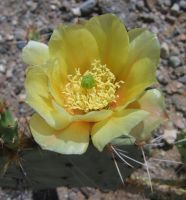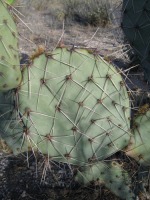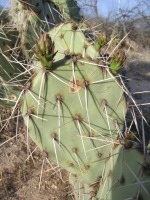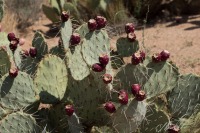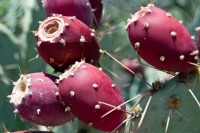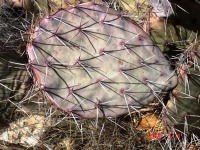Griffiths, Proceedings of the Biological Society of Washington 27(6): 28, 1914
Holotype; Isotype; Isotype; Isotype; Isotype; Isotype; Herbarium; Herbarium
Original Description
What is Opuntia confusa?
Opuntia confusa is an interesting pricklypear because some cladodes have spination similar to that of O. engelmannii, whereas other cladodes have spination similar to that of O. dulcis.
Details
In some of the obovate to subcircular pads, the spines are longer than on other pads. These longer spines are heavy, angular, and spreading as in O. engelmannii. Three or more major spines may be present. In contrast, spines on other pads are slender, one porrect and one deflexed (O. dulcis-like). Thus, there are two different types of spination in O. confusa that occur on different plants or even on different pads of the same plant.
The yellow flowers are 5-8 cm in diameter and darken to red or dark orange with age. Filaments are yellow and anthers are yellow. The style is pale and the stigma is green. Fruit is short-pyriform to subglobose and red. The fruit has a noticeable bloom that is lost at complete ripening at which time the fruit is dull red. Fruit spines may be reddish-brown.
Ploidy is unknown.
Other Details
O. confusa resembles O. dulcis in overall aspect and grows alongside it in some locations. However, the two do not produce hybrids. However, when they are growing together it can be seen that O. confusa is always smaller, rarely reaching 40 cm tall, and O. confusa pads average smaller as well.
O. confusa typically has large areoles with irregularly sized glochids that are scattered throughout areoles as in O. engelmannii. In contrast, O. dulcis generally has a tuft of glochids at the apex of an areole. O. confusa is a bluer plant than O. dulcis. Older (oldest) spines are darker on O. confusa than those of O. dulcis. The oldest spines of O. dulcis (on the oldest cladodes) may be black, especially in the western part of its range. See a table that compares O. confusa with O. dulcis.
O. confusa is a medium-sized and attractive garden plant because the flowers darken to red or near-red. Some forms may be hardy to USDA climate zone 7 or 8.
For more information, see:
Green C.W. and Ferguson D.J. (2011) PricklyPears Commonly Found in the United States and Canada. First ed. Worldcat.org No. 827221200.
Tucson area Opuntia, the pricklypears, XEROPHILIA • Volume VIII, No. 1 (25), August 2019 | ISSN 2285-3987










